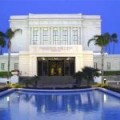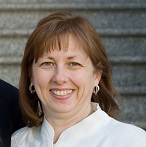 After most of the turbulence of the nineteenth century, which witnessed much persecution against the Mormons, the Mormon Church began to grow worldwide in the twentieth century. In 1915, President Joseph F. Smith announced the construction of the Laie Hawaii Temple, the first temple outside the continental United States. The Mormon Church had great success among the peoples of the pacific Islands and especially in Hawaii. The Temple was dedicated in 1919 by President Heber J. Grant. It was the first Mormon temple not to have an assembly hall and is also unique in not having a spire. Only three Mormon Temples do not have spires, and the other two were built at this same time: The Cardston Alberta Temple and the Mesa Arizona Temple. The Cardston temple, built in an area where Mormons had fled during severe persecution in Utah in the 1880s, was the first outside of the United States. This temple also hosted the first “Temple trips,” as Mormons in Canada and the Northwestern United States organized community excursions to the temple. Such trips have become traditional in many Mormon congregations today. The Mesa Temple was built in an area of high Mormon population, but which was not predominantly Mormon.
After most of the turbulence of the nineteenth century, which witnessed much persecution against the Mormons, the Mormon Church began to grow worldwide in the twentieth century. In 1915, President Joseph F. Smith announced the construction of the Laie Hawaii Temple, the first temple outside the continental United States. The Mormon Church had great success among the peoples of the pacific Islands and especially in Hawaii. The Temple was dedicated in 1919 by President Heber J. Grant. It was the first Mormon temple not to have an assembly hall and is also unique in not having a spire. Only three Mormon Temples do not have spires, and the other two were built at this same time: The Cardston Alberta Temple and the Mesa Arizona Temple. The Cardston temple, built in an area where Mormons had fled during severe persecution in Utah in the 1880s, was the first outside of the United States. This temple also hosted the first “Temple trips,” as Mormons in Canada and the Northwestern United States organized community excursions to the temple. Such trips have become traditional in many Mormon congregations today. The Mesa Temple was built in an area of high Mormon population, but which was not predominantly Mormon.
Since its earliest days, one of the basic beliefs of Mormonism has been in the necessity of missionary work, and the Church has sent missionaries to the entire world, teaching people in their own languages and working to build people up by teaching them the gospel of Jesus Christ, urging them to work hard in their communities and build up the Kingdom of God. By the early 1900s, Mormons could no longer feasibly gather together in Utah, but many came on pilgrimages to visit the temples. Growth of the Mormon Church in Latin America meant that by 1945, the Mormon temple ceremonies were being performed in Spanish, beginning first at the Mesa Temple.
 Poverty and the great wars of 1918-1945 slowed construction of other Mormon temples. In 1945, the Mormons completed the Idaho Falls Temple. During the 1920s and 1930s, Mormon missionaries had great success in Europe, especially in German-speaking countries, where tens of thousands joined the Mormon Church. By the end of World War II, the impoverished Mormons of Europe had shown great faith, and the Mormon Church worked to reward them with a temple in their midst. Mormon missionary success continued as well in the Pacific Islands and especially among the Maori people of New Zealand. In 1955, President David O. McKay dedicated the Bern Switzerland Temple. On April 20, 1958, he dedicated the Hamilton New Zealand Temple. The Bern Temple presented special problems, as it required that the Mormon temple ceremonies be conducted in multiple languages. Traditionally, the ceremonies had been performed with live persons leading it, but this became more difficult as many languages, including French, German, and Italian, would be required. To help with this, the Mormon Church began using films to present the instructional portions of the temple ceremonies, with translation headphones for those who could not understand the language being spoken. This allowed the Bern Temple to serve all the peoples of Europe using fewer staff members. At this same time, a temple was built in Los Angeles, California and London, England. The London temple was particularly important to Mormons, because so many converts had joined in England that at one point in the 1850s, there were more Mormons in Britain than in America.
Poverty and the great wars of 1918-1945 slowed construction of other Mormon temples. In 1945, the Mormons completed the Idaho Falls Temple. During the 1920s and 1930s, Mormon missionaries had great success in Europe, especially in German-speaking countries, where tens of thousands joined the Mormon Church. By the end of World War II, the impoverished Mormons of Europe had shown great faith, and the Mormon Church worked to reward them with a temple in their midst. Mormon missionary success continued as well in the Pacific Islands and especially among the Maori people of New Zealand. In 1955, President David O. McKay dedicated the Bern Switzerland Temple. On April 20, 1958, he dedicated the Hamilton New Zealand Temple. The Bern Temple presented special problems, as it required that the Mormon temple ceremonies be conducted in multiple languages. Traditionally, the ceremonies had been performed with live persons leading it, but this became more difficult as many languages, including French, German, and Italian, would be required. To help with this, the Mormon Church began using films to present the instructional portions of the temple ceremonies, with translation headphones for those who could not understand the language being spoken. This allowed the Bern Temple to serve all the peoples of Europe using fewer staff members. At this same time, a temple was built in Los Angeles, California and London, England. The London temple was particularly important to Mormons, because so many converts had joined in England that at one point in the 1850s, there were more Mormons in Britain than in America.
About Anita Stansfield
Anita Stansfield began writing at the age of sixteen, and her first novel was published sixteen years later. For more than fifteen years she has been the number-one best-selling author of women’s fiction in the LDS market. Her novels range from historical to contemporary and cover a wide gamut of social and emotional issues that explore the human experience through memorable characters and unpredictable plots. She has received many awards, including a special award for pioneering new ground in LDS fiction, the Lifetime Achievement Award from the Whitney Academy for LDS Literature, and also a Lifetime Achievement Award from her publisher, Covenant Communications. She has fifty-six published books. Anita is the mother of five, and has three grandchildren.



 Watch a video about the restoration of the gospel on lds.org
Watch a video about the restoration of the gospel on lds.org
Trackbacks/Pingbacks